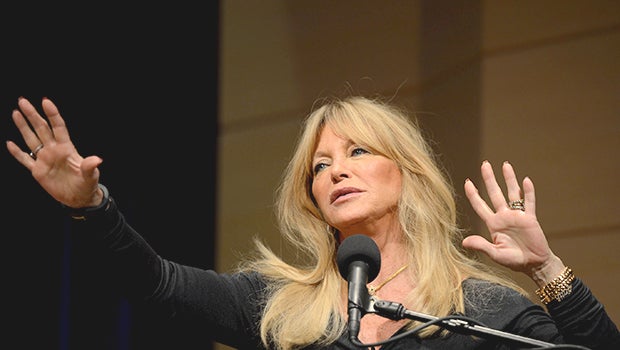It was a terrifying experience with a school drill on enemy attacks that was the inadvertent precursor to Goldie Hawn’s MindUP program, the actress told an Aspen audience at a Murdock Mind, Body, Spirit Series event recently.
A self-described happy and carefree child who decided from an early age that her “job in this life was to be happy,” Hawn was traumatized at age 11, when her sixth-grade class went to the school’s A/V room to watch what she assumed would be an agriculture film. Instead, blaring sirens and an ominous countdown led into an instructional movie about what to do in case of an enemy attack. (“They told us to hide under our desks when the Russians came — what would that do?” Hawn said, to audience laughter.)
The film put Hawn into a complete state of anxiety, and she ran home to tell her mother she was convinced that everybody was going to die. Looking back, she realized that her young, innocent brain was not able to assimilate or make sense of the information in the film, and instead of processing it as practical advice for an unlikely situation (as ludicrous as those Cold War videos seem now), watching it had put her into such a state of fear that she became frightened of sirens and didn’t want to go to school to avoid the possibility of having air raid practice.
Fast forward to 2014, and Hawn’s MindUP program, a social and emotional literacy curriculum and training program, serves over 400,000 children in schools across the United States and internationally. Created to help children deal with the stressors in their lives, it’s based on four pillars: learning about the neurology of the brain, taking “brain breaks” to help focus and quiet the mind, integrating mindfulness practices in a classroom curriculum, and teaching perspective. Hawn calls MindUP a sustainable program — as children and educators learn its principles, they have the tools to deal with their social-emotional selves for life — and teach others.
“This is something that affects all children, not just children in the inner cities or children of affluent backgrounds, who have other issues,” said Hawn. “This is a practice we should all learn, and the younger the better.”
Hawn explained the process that led from that “inciting incident” in the sixth grade to the creation of MindUP — and its potential future.
As a young Hollywood actress, thrown into the spotlight at age 19, Hawn recognized she had anxiety. She was afraid of being a star and wanted desperately to lead “a normal life,” she said. So she started seeing a psychologist, which triggered a lifelong interest in the field. She learned about her own brain, and went on to study brain science, spiritual practice, and meditation.
Then came 9/11. The tragic events of that day brought back all her childhood fears of the world coming to an end.
“And all I could think about was the children, because they’re inheriting a different world than the one we grew up in, a frightening and frenzied world where you can’t see your enemies,” Hawn said. “We should teach them how to live in this challenging time period.”
Given how her studies of brain science and meditation helped her, Hawn wondered why those subjects weren’t taught in school. So she pulled together experts in the field — including neuroscientists, cognitive psychologists, and teachers — and, as she puts it, “put them in a room for 18 months and came up with MindUP.”
That was twelve years ago. Since then, Hawn has been working on getting the program into schools, scaling it, and funding it and its expansion. She created the Hawn Foundation as an umbrella organization for the signature initiative, and tirelessly lobbies for promoting brain health and improving social-emotional awareness in children.
Early on, program leaders found that with mindfulness training, children have more management of their emotions, their executive functions are quicker, they cooperate better in the classroom, and they are less apt to be bullied. While other social-emotional programs are well intentioned, Hawn said, they tend to deal with problems such as bullying reactively or with a Band-Aid approach — telling kids not to bully instead of dealing with the underlying social-emotional situation.
MindUP, on the other hand, emphasizes cultivation of things like empathy — techniques include gratitude circles, journals, and acts of kindness. And according to Hawn, that kind of practice will change the brain, helping it to produce dopamine and serotonin, for example.
The foundation of the program is rooted in neuroscience, and teaching kids how their brains work. What’s been most impactful for Hawn, she related, is hearing young children explain to their parents and other adults how their emotions relate to their prefrontal cortexes, amygdala, or other parts of the brain. And seeing how this knowledge has helped MindUP kids has convinced her that neuroscience should be in every classroom in America, if not the world. “That’s my dream,” she said.
“This could mitigate mental health issues,” added Hawn. “For a better world for our children, what each and every one of us can devote some time and effort to, is to become mindful, to become a symbol for our children. That’s the job we have to do in this very troubled world.”
For more information on MindUP, visit the website at www.thehawnfoundation.org/mindup

